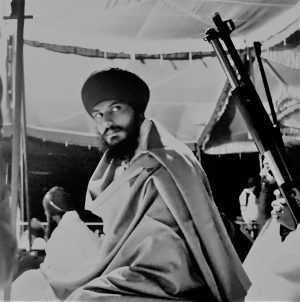Sudha Ramachandran

On February 23, scores of gun- and sword-brandishing followers of Amritpal Singh, a self-styled radical Sikh “preacher” and head of a so-called pressure group, Waris Punjab De (Heirs of Punjab), stormed a police station at Ajnala near Amritsar in India’s border state of Punjab. The mob was trying to force authorities to release a jailed associate of Singh.
In Singh’s words, the assault on the police station was a “show of strength.” It worked. Punjab’s Aam Aadmi Party (AAP) government caved in to his demand and released the aide.
This could boost Singh’s stature in the Sikh separatist and radical religiopolitical space in Punjab.
Singh, who propagates the formation of Khalistan, a sovereign state for Sikhs, is drawing large crowds in rural Punjab. This is a matter of concern as Sikh separatist militancy ravaged Punjab in the 1980s and was wiped out only in the mid-1990s.
In the decades since, Sikh separatism has remained alive among sections of the Sikh diaspora in Canada, but in India itself, it had more or less died out. However, there have been signs of its revival in recent years in Punjab.
It is in this context that Singh’s meteoric rise must be seen.
Till recently, Singh was working in his family’s transport business in Dubai. It was only in September 2022 that he returned to Punjab to take over the reins of the Waris Punjab De after the death of its founder-chief, Deep Sidhu, in February 2022.
Singh says he is inspired by Jarnail Singh Bhindranwale. A little-known Sikh preacher before he set out on his violent religiopolitical campaign for a sovereign Sikh state of Khalistan, the charismatic and controversial Bhindranwale spread terror across Punjab and holed himself up in the Golden Temple, Sikhism’s most sacred shrine located in Amritsar. In June 1984, the Indian Army carried out Operation Bluestar to flush out the Sikh militants from the Golden Temple and killed Bhindranwale.
The operation set off a chain of events, including the assassination of Prime Minister Indira Gandhi by her Sikh bodyguard, and anti-Sikh riots, which in turn kept fires of Sikh separatism alive for over another decade at least.
Singh is styling himself along the lines of Bhindranwale. The event where he was anointed Waris Punjab De’s chief was held at Bhindranwale’s native village of Rode. Like Bhindranwale, Singh wears flowing white robes and a navy blue turban and moves around Punjab surrounded by heavily armed men. Their rhetoric is similar; Singh spews pro-Khalistan rhetoric and glorifies the use of violence in his speeches. If Bhindranwale hid in the Golden Temple while issuing hit lists and sending out death squads to terrorize Punjab, Singh’s supporters marched into the Ajnala police station with a copy of the Guru Granth Sahib, the Sikh holy book, in their hands.
Like Bhindranwale, Singh is shielding himself behind religion. He is using religion to deepen insecurity, incite anger, and mobilize support.
Importantly, he has started issuing threats. He recently issued a threat to Home Minister Amit Shah, warning him that he would meet Indira Gandhi’s fate.
Singh’s rise has triggered unease in Punjab; it has rekindled fears of the return of Sikh militancy. Senior Punjab police officials are drawing attention to the role of gangster-terrorist networks with links to Pakistan’s Inter-Services Intelligence (ISI) that are active in Punjab. Indeed, India’s security establishment is warning that Singh’s rise is yet another attempt by the ISI to destabilize a sensitive Indian border state.
However, domestic factors too are fueling the revival of Sikh militancy. Sikh militancy is not a standalone development. It has come amid rising Hindutva in India. The Bharatiya Janata Party’s Hindutva agenda and the outpouring of hate against Sikhs on social media last year — which was accompanied by calls for a “repeat of the 1984” anti-Sikh riots — have triggered insecurity among Sikhs, making a small but growing number of Sikh youth receptive to militant appeals.
The AAP government in Punjab has come in for strong criticism for buckling to Singh’s demands. The BJP-led federal government can be expected to raise the bogey of the return of Sikh militancy to Punjab and the threat it poses to national security to remove the AAP government in the state.
The Punjab government has displayed immense ineptitude in dealing with law and order issues and separatist politics in the state. Singh and his heavily armed henchmen are strutting around in public and raising secessionist slogans. They have emerged triumphant from their faceoff with the police at Ajnala. The Punjab government will need to act before it is too late.
No comments:
Post a Comment